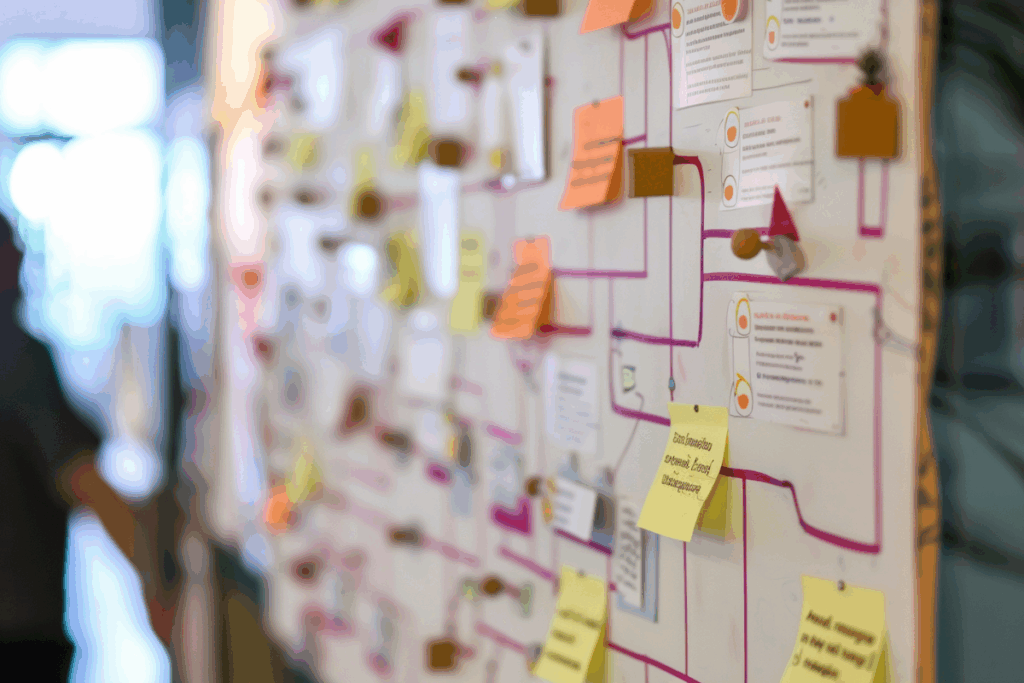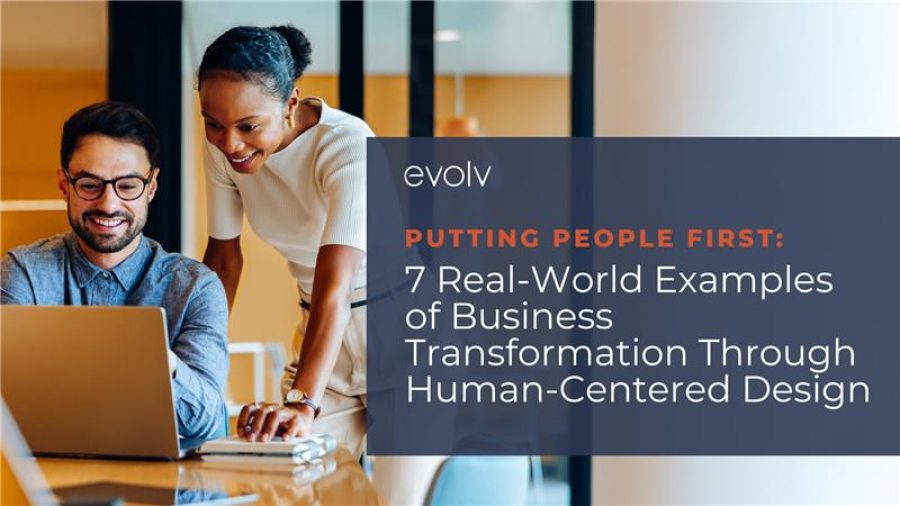by Alan Cannefax
Technology like data and A.I. are a big part of our work at evolv Consulting. But deploying technology, or really, any sort of transformative strategy without considering how people will interact with it is a recipe for failure.
Human-centered design prioritizes people by leading with key questions like, “What do people need? How can we help people with their problems? Can we make their lives a little easier?” Ultimately, we are answering the age-old question: “What are we solving for?”
Join us as we explore how human-centered design has shaped seven areas of business, with practical examples that illustrate how this approach can be effectively applied.
1. Business Strategy: A Human-Centered Approach to Growth
Traditional business strategy often relies heavily on market analysis, financial forecasts, and competitive positioning. While these are important, a human-centered approach adds a crucial layer—understanding what people truly value. This insight leads to strategic decisions that resonate more deeply with customers, stakeholders, and employees, driving sustainable growth.

An automotive parts retailer used multiple rounds of human-centered research (one-on-one interviews, surveys and group workshops) to understand why some customers weren’t buying from their e-commerce site. They discovered that trust was the No. 1 barrier. Customers wanted to see products in person before purchasing; specifically customers wanted to inspect replacement parts for quality and precision. The retailer responded by integrating a “buy online, pick up in store” (BOPUS) strategy, which allowed customers to digitally place orders and pick them up at a local branch. The BOPUS model meant customers could have their orders within an hour if needed, which proved especially popular for mechanic shops. By applying a simple strategy of putting the needs of customers first, the retailer increased conversion rates upward to nearly 50% and customer loyalty x2.
2. Digital Transformation: Putting People at the Center of Tech Evolution
Digital transformation can be overwhelming for organizations and their employees. It’s a process that can take years and lead to employee fatigue. The human-centered approach ensures new digital initiatives don’t just focus on cutting-edge technology alone but also takes into account how people will use them. This approach minimizes resistance to change, enhances usability, and improves adoption rates.
An automotive financial services company needed to implement a new customer relationship management (CRM) system. But because the client operated on decades old proprietary systems, making the switch was daunting. Knowing this, their employees were engaged early in the design phase to learn their preferences, understand their workflow challenges, and explore their pain points. By incorporating feedback loops into the new system’s design and launching a functioning prototype and then a MVP, our team ensured the new CRM system fit naturally into existing workflows, leading to a smoother transition and higher user adoption.
3. Connected Channel Strategy: Creating Seamless Customer Journeys
A connected channel strategy is about ensuring customers have a consistent and integrated experience across multiple digital touchpoints. This is mission critical for businesses that have wide generational appeal, but they often suffer from a dependency on monolithic systems, with internal resistance to change from leadership. Human-centered design plays a pivotal role in this by considering how people move between channels — whether it’s from a website to a mobile app or a social media post to an in-person transaction. Understanding these behaviors creates fluid transitions and cohesive journeys.
Our team worked with a telecommunications and media company to study how their customers interacted with different support channels. Our work visualized an end-to-end roadmap, validated by the clients’ key stakeholders, and identified pain points in transferring information between the channels through a current-state wireframe. We then created a future-state, solution-based prototype. Leadership’s resistance to system upgrades faded, as it became impossible to ignore the obvious benefits.

Our team plotted the strategy and led the delivery of the system upgrades, making the experience more convenient and connected, allowing customers to save session history across platforms. An unexpected benefit was the eased burdens that customer call and chat center agents experienced as a result.
4. Omni-Channel Strategy: Integrating Online and Offline Experiences
While a connected channel strategy focuses on digital touchpoints, an omni-channel strategy goes a step further by integrating both online and offline experiences. The goal is to create a seamless experience that adapts to where and how customers engage with a brand. Human-centered design ensures each touchpoint — whether it’s a brick-and-mortar store, an app, or an email — meets customers’ expectations and needs.
At a retail chain, we used a human-centered approach to study how customers shopped both in-store and online. Our findings showed many customers liked to browse online but preferred in-store purchases, a direct connection to the brand’s expensive price points.

In response, we proposed the retailer adopt a “Reserve Online, Try In-Store” feature, combining the convenience of digital browsing with the tactile reassurance of in-person shopping. By adding an augmented reality to the shopping experience, customers were intrigued to ‘see’ the product on their person. This led to increased ROI, higher conversion rates, and a more satisfying customer experience.
5. Employee Experience (EX): Enhancing Workplace Satisfaction
Just as we design experiences for customers, it’s equally important to consider the experiences of employees. Human-centered design in the workplace involves creating environments, processes, and tools that empower employees to do their best work. Happy, engaged employees lead to better customer service, higher productivity, and lower turnover. After all, in some cases, employees are the No. 1 customer for the brand.
“Employees are the No. 1 customer for the brand.”
A healthcare provider introduced a new project management tool, only to find employees were reluctant to use it. Using a human-centered approach, our team gathered feedback and learned the tool’s interface was overly complex. After simplifying the design, adding intuitive features based on employee needs, and launching an educational campaign, adoption rates increased by 50% and team productivity improved.
6. Learning Experience Design (LXD): Creating Effective Training
Incorporating human-centered design into learning experience design ensures educational content is engaging, accessible, and relevant. Whether it’s training employees or educating customers, designing with the learner’s needs in mind enhances retention and application of knowledge.

A pharmaceutical company wanted to introduce to their leaders a new organizational working model to increase team efficiency. Instead of delivering traditional training sessions, we used human-centered design to create interactive simulations that reflected real-world scenarios. Our support material included animated training videos with voice-overs, guided training sites with multiple choice quizzes, and 1:1 sessions. Our hands-on approach improved leader confidence in using the new model and meeting their efficiency goals.
7. Change Management: Navigating Transformation with Empathy
Change management is often one of the most challenging aspects of business. By applying human-centered design principles, organizations can minimize resistance and maximize engagement. This means involving people early, communicating effectively, and designing transition processes that make change feel manageable and beneficial.
This last example focuses on a housing manufacturing supply company facing significant resistance during a shift to a new enterprise resource planning (ERP) system. Instead of enforcing a top-down implementation, they used human-centered design to involve teams in co-creating the change process through playbooks. Employees provided feedback on pain points and participated in user testing, leading to a more refined and accepted rollout. The result was guiding the teams through 15 different departmental, interactive playbooks instead of development of new standard operating procedure manuals. Adoption rates exceeded 90%, and productivity remained steady throughout the transition.

The Connection to Usability and User Adoption
Across all these areas, the thread of usability is central. Usability isn’t just about a user-friendly interface; it’s about making every aspect of an organization — tools, systems, processes — intuitive and engaging. Usability boosts user adoption, whether it’s customers using a product, employees navigating new software, or stakeholders buying into a strategic change.
When people find a system or strategy easy to understand and use, they are far more likely to embrace it, engage with it, and advocate for it. Poor usability, on the other hand, leads to frustration, disengagement, and resistance, outcomes that can derail even the most well-intentioned initiatives.
Conclusion: Building Better Organizations through Human-Centered Design
Human-centered design isn’t a one-size-fits-all solution. It’s a philosophy that requires research and a deep understanding of the people you serve as well as a commitment to meeting their needs. By extending this approach beyond traditional UX to include strategy, digital transformation, connected and omni-channel strategies, customer and employee experiences, learning design, and change management, we help shape more resilient, adaptive, and successful organizations.
If you’re seeking to apply a holistic, human-centered approach in your organization— whether you’re developing a new product, navigating digital transformation, or designing an engaging customer experience—let’s connect. Together, we can create solutions that truly matter, for people and businesses alike.
Alan Cannefax is a seasoned creative executive with decades of experience in digital strategy, communications, and design. As a senior leader and trusted partner, he brings clarity to product vision, advocates for user-centered solutions, and aligns design excellence with business goals. Known for building high-performing teams, Alan is passionate about crafting impactful digital products and services that improve lives and solve real-world challenges.




